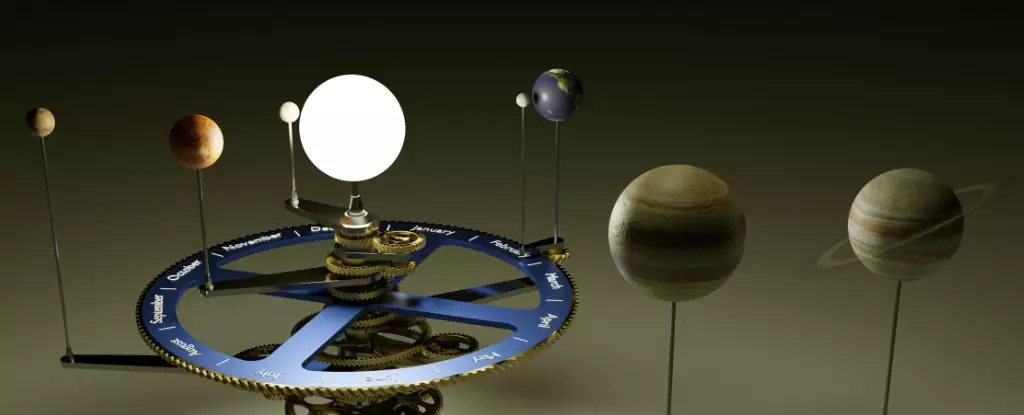As the whispering clouds of dusk settle over our planet, a magnificent celestial dance unfolds. The sky is set to dazzle stargazers, presenting an extraordinary opportunity to witness multiple planets aligning—a rare sight that should not be missed. Come March 2025, including Mercury, all naked-eye planets will grace the heavens, making this an exceptional month for astronomy enthusiasts.
After a brief absence, Mercury, the elusive inner planet, finally makes its presence known in the sunset lineup. Notorious for its swift movements and proximity to the Sun, Mercury typically escapes the attention of many observers. However, as January’s headlines hinted at the possibility of seeing multiple naked-eye planets, it became clear that Mercury was the missing link in this cosmic ensemble. Skirting low on the western horizon, it requires a keen eye and a bit of patience, especially following its solar conjunction on February 9.
This month, astrophotographers and stargazers are encouraged to utilize Venus as their guiding light to successfully spot Mercury. The positioning of these two planets is particularly tantalizing, as Mercury will be located just north of Saturn on February 25—a striking celestial moment. As March approaches, the planets will continue their tango, culminating in the crescent Moon’s occultation of Mercury on March 1 for viewers in Hawaii and the Pacific.
As February wanes, Mars is emerging as a prominent feature in the night sky. Following its opposition on January 16, Mars shines brightly in Gemini, poised to captivate audiences with its ruddy hue. Observers can expect a visual treat when the waxing gibbous Moon meets Mars on March 9. This exceptional configuration offers an ideal opportunity to enhance observational skills and capture breathtaking photos of two celestial bodies in close proximity.
While preparation is key for capturing such images, it’s also vital to remember the intriguing projects associated with Mars. NASA’s ESCAPADE mission will be launching this year, pushing the frontiers of Mars exploration and igniting the astronomical imagination. With ongoing missions and a flurry of celestial events, there’s no better time to deepen one’s understanding of the Red Planet.
As dusk settles in, Jupiter, the giant among planets, takes its rightful place in the southern sky, radiating brilliance in the constellation Taurus. The planet will reach quadrature—a position at a 90-degree angle relative to the Sun—on March 2. This is an exciting moment for astrophotography, as the illumination of Jupiter enables sharper resolutions and highlights the details of its many moons.
Observers can also look forward to the waxing near-first quarter Moon intersecting with Jupiter on March 6, further enhancing the visual spectrum. Historically, this alignment has not only fascinated amateur astronomers but has also been a touchpoint for scientific discovery. The Danish astronomer Ole Rømer made significant strides in understanding the speed of light through careful observations of Jupiter’s moons, showcasing how observation can lead to scientific enlightenment.
Yet amidst the breathtaking beauty of Mercury, Venus, Mars, and Jupiter, the outer planets offer both challenges and rewards. Saturn, for instance, sits low on the horizon, cloaked in the murky twilight. Binoculars may assist in spotting this planet, faint yet magnificent with its rings nearly edge-on to Earth. Observers are encouraged to make note of March 23 when Saturn will be at its edge-on position. This moment is not merely about aesthetics; it’s an excellent opportunity to appreciate the scientific importance of observing the distant worlds.
Uranus and Neptune add another layer of complexity to this celestial narrative. Bright enough to be tracked with binoculars, Uranus resides near Jupiter, while Neptune hides in the murky twilight along with Mercury and Saturn. These discoveries remind us of the ever-evolving narrative of astronomy, tethered not only to the naked eye but also fueled by the tools and techniques that contribute to understanding our universe better.
Anticipating the Future of Skywatching
As the planetary assembly unfolds and wanes, the sky’s offerings will shift dramatically. As Mercury and Venus re-emerge in the dawn sky, anticipation mounts for the upcoming eclipses set to occur next month—a partial solar eclipse on March 29 and a total lunar eclipse on April 14. With spring weather notoriously fickle, skywatchers must remain hopeful for clear conditions to fully engage with these celestial spectacles.
March presents an enchanting tableau for those captivated by celestial wonders. From the elusive Mercury reclaiming its place alongside the other planets to Jupiter’s commanding presence, each observation opens up new avenues for exploration and appreciation. As the earth rotates and the heavens shift, we should embrace this opportunity to foster our curiosity and deepen our relationship with the cosmos. May clear skies accompany your planetary quest.


Leave a Reply